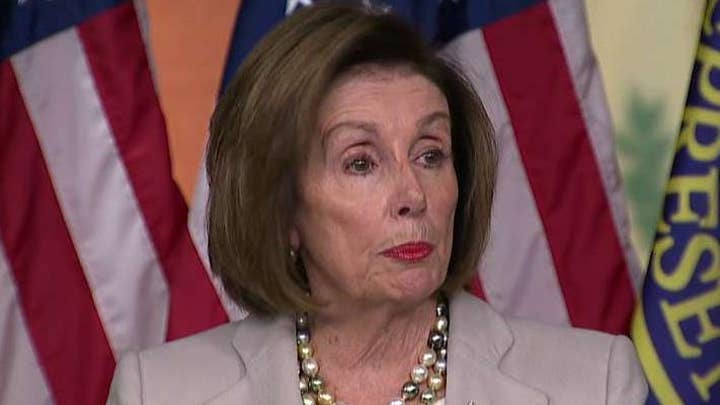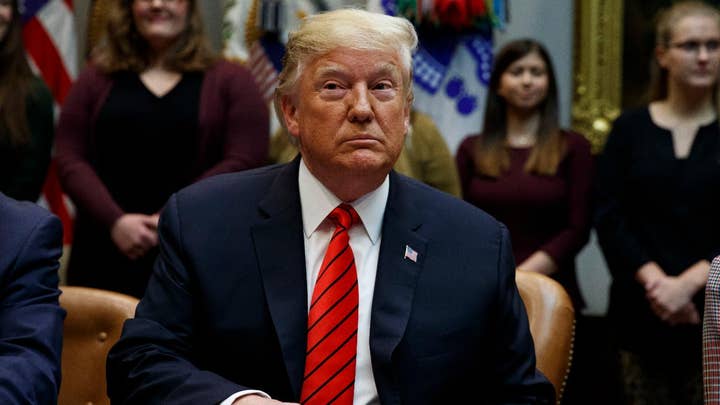135 House Republicans co-sponsor resolution to censure Schiff over Trump call parody
Reaction and analysis from North Carolina Rep. Mark Meadows and Ohio Rep. Jim Jordan on 'Hannity.'
CAPITOL HILL – Just last year, a lost studio album by the jazz great John Coltrane was unearthed. Coltrane recorded the tracks in 1963. The album is titled “Both Directions at Once.”
The name of Coltrane’s work epitomizes what Democrats are trying to do with impeachment right now – and everything else on Capitol Hill. Go both directions at once.
After all, Democrats dove headfirst into the impeachment inquiry surrounding President Trump this week. It became “real.” House Speaker Nancy Pelosi, D-Calif., had announced her support for the inquiry nearly a month ago, but Congress soon afterward departed Washington for a weekslong recess in late September.
When lawmakers returned to Capitol Hill last Tuesday afternoon, impeachment truly got real. Most members started pouring back into the Capitol after 4 p.m. ET Tuesday. Pelosi conducted a series of leadership meetings. The House began a vote series on the floor at 6:30 p.m., but Democrats scheduled a rare caucus meeting for 6 p.m.
Democrats usually hold their weekly caucus meeting the next morning - the day after members return to Washington. But, an additional caucus conclave – especially in the evening – surely meant something’s up.
Reporters also flooded the Capitol last Tuesday afternoon, knowing impeachment was “getting real” as lawmakers returned to Washington. The House Intelligence, Oversight and Foreign Affairs Committees already had run through several days of closed-door interviews with witnesses over the recess, but it was altogether different with all the lawmakers back in town. What had their constituents told them about impeachment? Was this the right thing to do? Were Democrats playing this wrong? Will Republicans break with the president?
Pelosi led an afternoon news conference with House Education & Labor Committee Chairman Bobby Scott, D-Va., about college affordability. Naturally, a few reporters peppered Pelosi with questions about impeachment, not tuition costs. One question centered on why the speaker wouldn’t call a vote on the floor to formalize the impeachment probe. Republicans have crowed for days that Democrats weren’t handling impeachment properly without such a vote.
During the news conference with Scott, Pelosi suggested she might say something about such a formal vote after meeting with her leadership team and caucus.
The Capitol buzzed.
But, when various members of Pelosi’s inner circle left the leadership suite a couple of hours later, nobody seemed sure if the speaker would call a vote.
“If that’s what she’s planning,” one Democrat said, “She’s holding her cards really close.”
That’s when Pelosi’s staff announced a rare evening news conference. “6:30” was the prospective time, but insiders suggested it would really start closer to 7 p.m. with roll-call votes on the floor and the full caucus huddling. Surely the speaker had a big announcement about impeachment to summon reporters to the House studio at that hour.
Republicans have demanded a vote for weeks. It wasn’t long ago that they planned to weaponize such a roll-call tally against Democrats representing swing districts. A vote to establish the parameters of the impeachment inquiry by the full House – which happened in 1974 with President Richard Nixon and in 1998 with President Bill Clinton – would be different from actually voting to impeach. But, Republicans supposedly thought they could boomerang that vote against the 31 Democrats in districts where Trump had prevailed. Republicans would ask, do those Democrats support an “extreme” idea like impeachment propounded by Pelosi, or are they with the president?
But, the idea of a vote on the structure of impeachment may have evolved. The Trump administration has been adamant it won’t cooperate with the Democrats’ impeachment investigation without a vote. So, one wondered if Pelosi might take them up on that dare. The administration wouldn’t have a leg to stand on if the House approved such a resolution. President Trump’s defenders in Congress have spent most of their time arguing about the process. They want process? Well, Democrats could well give them “process.”
“I’m certainly open to that,” said Rep. Dean Phillips, D-Minn., when asked about such a vote. “Most of us are on the record about that already.”
But, contrary to the thinking a few weeks ago, a vote to set parameters of the inquiry could flip on Republicans. For some House Republicans from Texas, North Carolina, Florida, Nevada and Michigan, a vote for an impeachment inquiry could be problematic. If those swing-district Republicans vote against the inquiry, Democrats may well have weaponized the vote against the GOP. Moreover, if any Republicans vote with the Democrats for “an inquiry,” each likely will face a Trump-aligned challenger. That’s to say nothing of drawing the ire of the president himself. If vulnerable Republicans oppose launching the investigation, they could face trouble in the general election.
TRUMP SAYS PELOSI SHOULD INVESTIGATE OBAMA'S SYRIA RED LINE, SCHIFF SHOULD BE 'DEPOSED'
But, there would be no such vote.
As reporters waited in the House studio, word filtered in that Pelosi would not call a vote to formalize the impeachment process. But, the speaker would have a special guest at the news conference: House Intelligence Committee Chairman Adam Schiff, D-Calif.
Pelosi’s press event began precisely at 7 p.m. –initially sans Schiff. And, instead of updating reporters on impeachment, Pelosi spoke about a myriad of other subjects: efforts to reduce the cost of prescription drugs, the college tuition legislation, the U.S.-Mexico-Canada Agreement, firearms, sanctions against Turkey. The speaker barely said anything about impeachment until Schiff arrived.
Only, it wouldn’t be Pelosi addressing impeachment. Pelosi would yield to Schiff.
What happened next was remarkable.
Actions speak louder than words. Pelosi then walked off the dais, leaving Schiff at the lectern. Pelosi took a seat in the front row of the Radio/TV Gallery Studio, amid the reporters, to listen to Schiff. All she lacked was a notebook and a tape recorder.
There are lots of ways to read Pelosi’s decision to defer to Schiff. It was almost to indicate that impeachment was under Schiff’s silo, and his only. Congressional leaders frequently have liked to cede power to their committee chairs – or, at least, give the illusion of ceding power to committee chairs. Perhaps the speaker was distancing herself from impeachment, or indicating that the House would conduct its impeachment investigation and simultaneously work on other legislation. A skeptic might have viewed Pelosi’s decision to sit in the front row as a way to divorce herself from the impeachment inquiry, or say, “Adam, it’s all on you. Don’t screw this up.”
CLICK HERE TO GET THE FOX NEWS APP
That’s the narrow path Democrats must now walk – balancing impeachment with discussions about education, trade, guns and medicine. But, impeachment has seemed to consume nearly every headline, every conversation at the Capitol. It’s unclear how Democrats could slice through the impeachment noise with their other messages. Impeachment could be seen as just too muscular. Perhaps Democrats trod this path at their own peril.
There’s only one way to walk that course. Or, as John Coltrane might say, go “Both Directions at Once.”








